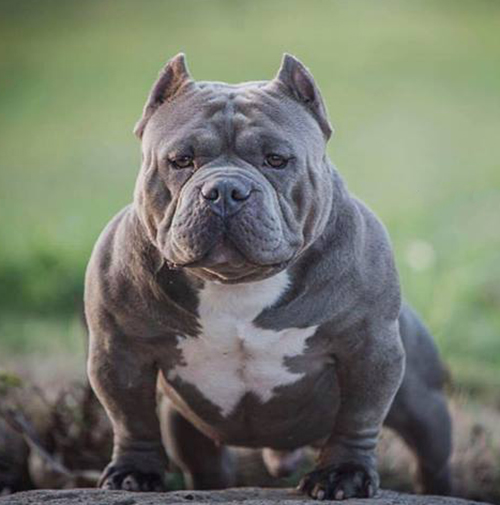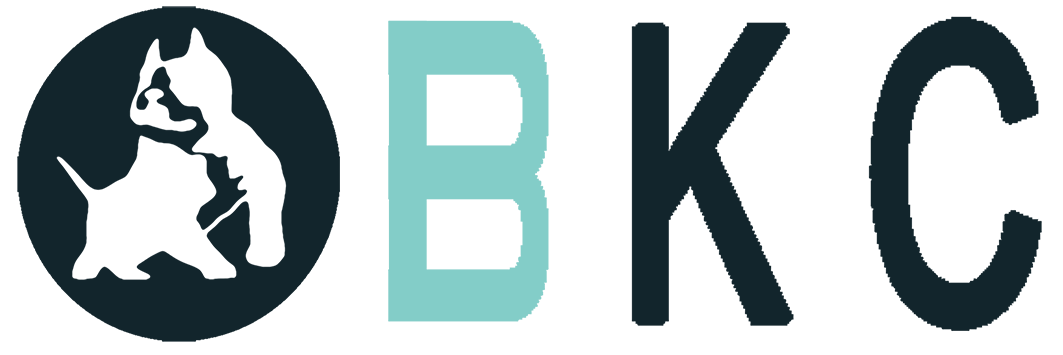
HISTORY
The Ex-Am or Exotic-American Bully is the most recent class of American Bully. It is a class that breeders have developed out of necessity, due to the more extreme traits not being desired in the Standard American Bully, but in high demand within the American Bully community. By taking certain strains, with more exaggerated features and placing them on shorter frames with sound structure to create a unique type of American Bully, the Ex-Am Bully is a combination of an Exotic and American Bully look. The beginning strains of this class began to surface in the early 2010’s. Features such as the Heads were becoming bigger, as the dog was becoming shorter with more exaggerated features, such as slightly bowed elbows, bigger bone and more mass.
GENERAL IMPRESSION
The Ex-Am Bully should give the impression of a smaller, more compact & American Bully, with more exaggerated features. When you look at the Exotic-American Bully, you will know it isn’t a Standard or Pocket American Bully, but it isn’t quite an Exotic Bully; but should give the impression of the PERFECT cross.
HEAD
Head is to be large and prominent with top skull being flat, not domed between ears. Head will be large, in proportion to body size. Eyes to be set apart, and low on skull, generally set directly underneath the medial border of the helix (part of ear which sits on top of the skull). Eyes should have an almond shape or circular shape, having tight skin around the eyelids. Muzzle to be of short or medium length with a very pronounced stop and fall away, with well-developed and chiseled cheek muscles to give the impression of strong biting power on lower mandible. Lower jaw shall be well developed not weak and may be evenly set with the dog’s flew. General impression should have the appearance of good gripping strength. Face outline should not be completely circular, or completely squared, but a mixture. The top of the head should give the impression of a square shape, while the bottom should give the impression of a half circle. Ears are to be set high on the skull and not to close together. Face may have wrinkles and loose skin around the cheek, and forehead area, but not to where the dog is confused with a bulldog. Also slightly loose flews acceptable but not desirable. Bite on the Exotic American Bully may be more undershot than the Standard American Bully, but teeth should never show while the dog has an alert expression.
FAULTS
Head disproportionate (too big/too small)
Skin too loose
Head is completely circular or completely squared
Head domed between ears
Underbite to exceed ½”
Overbite to exceed ½”
Eyes set too far apart
Eyes too close together
Eyes set too high/low
Long, pointy muzzle
Muzzle flat on face
Bulging eyes
Sunken eyes
Loose eyelids
Wry jaw
Eyes differing in color
Disqualifications
Albinism (Pink eyes, lack of pigment)
Teeth protruding while mouth closed
Wrinkled beyond breed type
Neck is to be short to medium length with a medium to large arch and widening from the base of the skull to the shoulder blade. Slightly loose skin in this area is acceptable.
Faults
Weak/Thin neck
Long neck
Excessive wrinkles
EARS
Cropped or uncropped is permissible. Uncropped ears should be rose, half prick or stand erect. Full drop is permissible but not desirable.
FOREQUARTERS
The preferred front on any class of American Style bully is straight, with the Exotic style American Bully being an exception. The Exotic American Bully class is allowed to have either straight or rounded front build. Must have well boned forelegs set rather far apart at the shoulders. Feet are of medium size with tight pasterns, which are strong, tight and upright. Feet may turn out a little at the pastern but is not desirable. Elbows should sit directly underneath shoulders, but a slight protrusion in the Exotic American Bully is desirable.
Faults
Feet resting under chest due to extreme bow
Weak pasterns
Front too wide in proportion to body
Shoulders considerably more narrow than elbow protrusion
(2)
HINDQUARTERS
Hindquarters should be well muscled. Good inner and outer muscling of the thigh. Rear stifle to have adequate bend with hocks well let down, forming an upside down capital “L”. Legs are parallel when viewed from the rear. Wider hip placement allowed in the Exotic American Bully. Straighter stifles, with slight bend are also permissible, but not desirable.
Faults
Cow hocked
Sickle hocked
No bend in stifle
Over angulated
High set hocks
BODY
The body of an Exotic American (Ex-Am) Bully is almost identical to that of a Standard American Bully, with the only differences being Ex-Am Bullies are shorter and more compact. Also a slight rise in the loin is permissible, but not desirable.
Faults
Body length longer than body height
Weak hip placement
Thin rib cage
Loin rise too high
TAIL
Short in comparison to body. When the dog is relaxed, the tail is carried low and extends approximately to the hock. Appears to be carried like an old fashion water pump handle when viewed from the side. Set low on rump tapering to a fine point. When the dog is moving, the tail is carried level with the backline. When the dog is excited, the tail may be carried in a raised, upright position (challenge tail), but never curled over the back (gay tail).
Fault
Challenge tail
Short Tail
Long tail
Kinked tail
Serious Fault
Screw tail
Bobbed tail
Disqualification
Gay tail
Docked tail
COLOR
Any color or color pattern is permissible or combination of color is acceptable. Even Merle.
Disqualification
HEIGHT AND WEIGHT
Males should weigh 45 to pounds 80 pounds fully grown. Height should be 13 to 15 inches tall.
Females should weigh 35 to 70 pounds fully grown. Height should be 12 to 14 inches tall
EYES
Any color acceptable. Must have pigmentation around eyelids. Eyes are to be set low and far apart on the skull.
Disqualification
Pink eyes, Albinism
Different color eyes
(3)
GAIT
Gait will be heavy with a tendency to roll. Dog should convey a demeanor with self confidence and an impression of great power and a zest for life for its size. When trotting, roll may become accentuated. Front legs may turn slightly out. Rear legs to track in a straight line. As speed increases legs should converge to the centerline.
Faults
Traveling to close
Traveling to wide
Legs not traveling on the same plane
Crossing over
Pacing
Hackney movement
COAT
Coat should appear short, smooth, glossy and in good condition. Coat should be moderately stiff to the touch when brushed in one direction.
Faults
Wavy coat
Sparse coat
Disqualifications
Long coat
No coat
DISQUALIFICATIONS
Extreme shyness or viciousness
One or both testicles not dropped (by six months of age)
Deafness in one or both ears
Albinism in eyes
Long coat
Standard written by Mario Johnson on February 11, 2018
